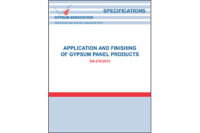Contractors and drywallers in the building trade are often presented with the task of isolating sound of one room’s noise from the next. The art of soundproofing a common wall or a common floor or ceiling assembly can bring a mix of opinions and strategies as to what might work best. Too often the answer centers around insulation techniques that will stuff or blow batting into the cavity spaces between the studs in a wall or the joists in a ceiling. Unfortunate to most, while the treatment separates rooms thermally, it does little to separate them acoustically. Noise will continue to travel from room to room.
It’s Not About the Stuffing
The key to combating sound bleed to deliver luxury grade STC ratings of 55 or greater is to understand how noise bleeds through the common surface better. Much like a string pulled tight between two coffee cans, it is the actual framing within the wall or ceiling assembly that is connecting rooms together. These structural connection points, if left connected, combine to serve the same function as the string. Vibrations will carry back and forth structurally between the rooms, regardless of what is stuffed in between the studs. The stuffing ignores the path.
Halfway There
The first goal in the art of soundproofing a common wall or ceiling is to understand the need for disconnection. A double wall, a staggered stud assembly or isolation clips with hat channels are all popular methods for breaking the connection points between adjoining rooms. Transmitting sound waves will collapse within the wall assembly rather than pass through to the other side, but you’re only half way there with the treatment.
Adding Density
The balance of your treatment targets the addition of density into your assembly.
Think of taking the flat of your hand and pressing it against a wine glass, a guitar string, the face of a drum or the prongs of a tuning fork. With the mass of your touch, the object’s ability to vibrate is killed. The wine glass can’t sing. The tuning fork can’t ring. The same holds true for your common wall or ceiling assembly. By simply adding density to the surface, you impede the wall or ceiling’s ability to resonate. As a result, the surface is less able to accept airborne sound wave vibrations, which in turn, hinders its ability to transfer the noise.
Let’s Not Take it “Old School”
So what we’ve learned is that by adding “mass” to a common wall or ceiling assembly, and disconnecting the framing structure, the transmitting sound wave will collapse within the assembly rather than pass through to the next room over. This quells the old school approach of stuffing insulation between the studs, which actually ignores the true path the energy is taking, and helps explain why results are so poor when trying to use batting insulation to soundproof a wall.
So How Does One Add Mass?
Contractors and builders that recognize the physics behind the proper isolation of noise transfer are familiar with a product called mass loaded vinyl. This thin sound barrier membrane can layer up to new build, remodel or finished existing surfaces. The weight of the membrane will force the collapse of resonance, and prevent the assembly from accepting airborne or structure-born vibrations. Used in conjunction with your disconnected framing technique, the combination can force the collapse up to 90 percent of your transmitting noise. As a result, luxury grade STC ratings of 55 or greater can be achieved.
Today’s builders will sometimes opt for pre-engineered drywall over mass loaded vinyl. The goal remains the same—adding density into the assembly to help arrest the transmission of noise. The value with the mass loaded vinyl technique is often recognized as the superior option. This is due to the layering technique of extracting the density out and away from the drywall, along with a dead air gap, to produce stronger insulation values. Much like layering clothing to insulate against the cold, it’s best to layer than to don a single heavy jacket.
Conclusion
Remember that this soundproof layering system is only as good as the amount of flanking paths that will combine to decay your values back. Outlet plates, supply/return vents, light canister cutouts, doors, windows, plumbing fixtures, etc., will all combine to decay your STC values back. As such, there should never be a 100 percent expectation to eliminate noise bleed—it cannot happen.
However, taking 70 to 90 percent of your noise bleed out of the equation can happen. Results will vary on every project based on the quality of the installation, flanking paths, frequencies of sound and accuracy of any sound meters used to test the results. Care should be given with the customer to set expectation levels accordingly, and never, ever rely solely on batting insulation alone to deaden the bleed of noise through your common wall or ceiling assembly.










